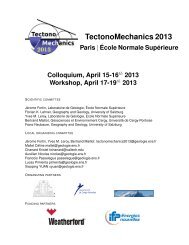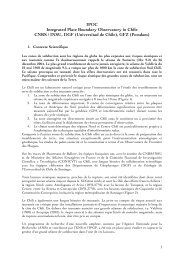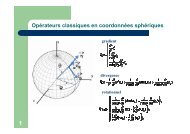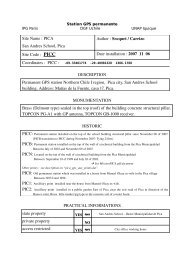PDF file - Laboratoire de Géologie de l'Ecole normale supérieure - Ens
PDF file - Laboratoire de Géologie de l'Ecole normale supérieure - Ens
PDF file - Laboratoire de Géologie de l'Ecole normale supérieure - Ens
You also want an ePaper? Increase the reach of your titles
YUMPU automatically turns print PDFs into web optimized ePapers that Google loves.
exception of AMMN and, to a less extend of KHOS<br />
and REIH, the residual velocities are small at all sites<br />
(< 2 mm/yr) and show no systematic trend (Figure 6).<br />
Even at KHOS and REIH, the misfit does not exceed<br />
the 2-σ uncertainty. We thus consi<strong>de</strong>r that these<br />
residual velocities represent the noise of our solution<br />
and therefore <strong>de</strong>monstrate the rigidity of the Arabian<br />
plate at this level of around 2 mm/yr, or less than 10 -9<br />
strains/yr.<br />
Relative plate motions<br />
A first test of our results and their implications is to<br />
compare the predictions in terms of relative motion<br />
with observations. The relative rate shown by our data<br />
between ADD1 in Ethiopia (west of East African Rift)<br />
and AR00, CBL0, LLL0 and GOR0 in Djibouti (east of<br />
the East African Rift) is about 5 mm/yr, east-west<br />
trending, consistent with other estimates of the East<br />
African Rift separation rate. Bilham et al. [1999] used<br />
a combination of SLR and GPS data to <strong>de</strong>rive a rate of<br />
4.5+-1 mm/yr at N108°+-10E across the northern<br />
Ethiopian rift at the latitu<strong>de</strong> of Addis Ababa, in good<br />
agreement with previous "geological" estimates of<br />
Jestin et al. [1994] (5 mm/yr at N102°E) and Chu and<br />
Gordon [1999] (6 mm/yr at N95°E). Combining our<br />
African and Somalian angular velocities gives a<br />
Somalia/Africa vector of relative motion at (28.95°S,<br />
43.70°E, 0.084°/Myr) which is only slightly east of<br />
Chu and Gordon’s [1999] “geological “solution but<br />
very different from that of Fernan<strong>de</strong>s et al.’s [2003].<br />
However, due to the close locations of the two African<br />
and Somalia vectors, their sum is very sensitive to<br />
small variations (either in pole location or in angular<br />
rate) and the result is quite erratic in the absence of<br />
further constraints (see a discussion of this effect in<br />
combining two nearby poles in Jestin et al., 1994).<br />
This is well illustrated by the large uncertainties<br />
obtained in combining the two covariance matrixes<br />
(semi-axes of the 1-σ error ellipse are 11° and 4°).<br />
Thus the only way to <strong>de</strong>termine with confi<strong>de</strong>nce a<br />
Somalia-Africa pole would be to compare it with<br />
measurements, which unfortunately are still lacking in<br />
the central and southern parts of the East African Rift.<br />
Arabia-Africa: the Red Sea and the Levant fault<br />
Combining our African and Arabian rotations leads<br />
to an angular velocity vector (31.64°N, 20.29°E,<br />
0.308°/Myr) (Table 4). The RMS misfit on observed<br />
velocities is less than 1.2 mm/yr. Our pole is close in<br />
latitu<strong>de</strong> and longitu<strong>de</strong> (within 1 sigma, ie. around 3°) to<br />
those of Jestin et al. [1994] and Chu and Gordon<br />
[1998], established from oceanic magnetic anomalies<br />
in the Red Sea. It differs more in longitu<strong>de</strong> from both<br />
McClusky et al. [2003] and Sella et al. [2003] (5° and<br />
9° respectively, i.e. more than 2 sigmas). However, it is<br />
our rate which differs more: we confirm that the<br />
geo<strong>de</strong>tic angular rate of rotation is significantly smaller<br />
than the “geological” one (0.308°/Myr ±0.05 at 3<br />
sigmas vs. 0.400 to 0.418°/Myr, with a pole longitu<strong>de</strong><br />
VIGNY ET AL.: ARABIA PLATE MOTION<br />
11<br />
however slightly more to East). McClusky et al. [2003]<br />
already suggested some reduction of this rate (with<br />
0.37°/Myr) but did not consi<strong>de</strong>r this reduction to be<br />
significant because of their larger uncertainty of<br />
0.04°/Myr. Compared to Chu and Gordon’s [1998]<br />
estimates based on magnetic anomalies, the Red Sea<br />
spreading is reduced from 9 mm/yr in the northern part,<br />
and 18 mm/yr in the southern one, to 8 and 15 mm/yr,<br />
respectively, thus by about 15%. The difference is<br />
clearly hardly significant, but corroborates an actual<br />
<strong>de</strong>crease in the Red Sea spreading rate since 3 Ma (or<br />
less), as argued by Calais et al. [2003] for the Africa-<br />
Eurasia-North America relative motions. Meanwhile,<br />
our predicted azimuths (023 and 044 in northern and<br />
southern Red Sea, respectively) are slightly more<br />
northerly than those predicted by Chu and Gordon<br />
[1998] (026 and 047). Again, those very small<br />
differences of 3° in direction are not really significant.<br />
Anyhow, since there is no clear transform directions in<br />
the Red Sea, we cannot test those predictions. In<br />
conclusion, if inferred on Red Sea data only, one could<br />
still argue against the <strong>de</strong>crease in rates of plate motion.<br />
Taking their uncertainties into account, GPS and Nuvel-<br />
1A rates are almost indistinguishable there.<br />
Along the Levant (Dead Sea) Fault system,our<br />
predicted rate of 7 mm/yr is very close to both the<br />
8 mm/yr predicted by Chu and Gordon [1998], and the<br />
6 mm/yr given by McClusky et al. [2003] but twice the<br />
4 mm/yr predicted by Sella et al. [2002]. All these<br />
estimates fit well with the 4+-2 mm/yr geological<br />
estimate of Klinger et al. [2000]. Based on three GPS<br />
stations and a locked fault mo<strong>de</strong>l (because two GSP<br />
stations – KATZ and ELAT - are close to the fault),<br />
Pe'eri et al. [2002] infer a 2.6+-1.1 mm/yr north-south<br />
component of motion, which is therefore a minimum<br />
estimate. Based on a larger network of 11 stations,<br />
Wdowinski et al. [2004] obtained a current slip rate of<br />
3.3+-0.4 mm/yr along the Levant fault system. This<br />
however might not be directly comparable to our 7<br />
mm/yr estimate since GPS data show a significant<br />
motion of the Sinai sub-plate with respect to Africa.<br />
Wdowinski et al. [2004] predict a 2.4 mm/yr velocity<br />
along azimuth 201° across the Suez rift, between Sinai<br />
and Africa. This azimuth is nearly the trend of the<br />
Levant fault, which implies a total relative motion of 5.7<br />
mm/yr between Arabia and Africa, in very good<br />
agreement with McClusky et al. (6 mm/yr) and our<br />
estimate (7 mm/yr).<br />
Arabia-Somalia: the Gulf of A<strong>de</strong>n<br />
A further test of a possible slowing down of the<br />
Arabia motion is to look at the Gulf of A<strong>de</strong>n.<br />
Combining our Somalia and Arabia motions relative to<br />
ITRF2000 gives an angular velocity vector (20.07°N,<br />
25.49°E, 0.356°/Myr) (Table 4). This is significantly<br />
different compared with all previously proposed<br />
solutions. When the Arabian sites velocities are rotated






